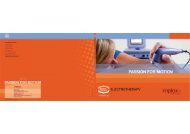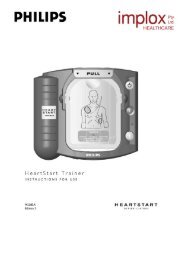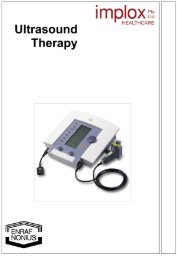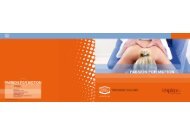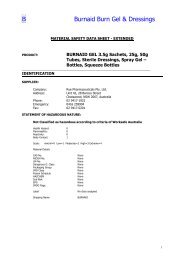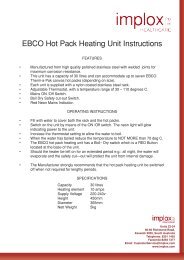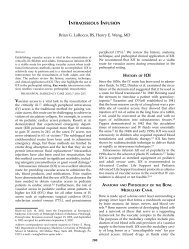Directions for Use - Implox
Directions for Use - Implox
Directions for Use - Implox
You also want an ePaper? Increase the reach of your titles
YUMPU automatically turns print PDFs into web optimized ePapers that Google loves.
2-3<br />
6. Place the defibrillator in the carry case, pressing it firmly into place. Insert the<br />
Quick Reference Guide,* face up, in the clear plastic window on the inside of<br />
the case. If you purchased a spare SMART Pads Cartridge or an Infant/Child<br />
Pads Cartridge, place it in the storage area in the case.<br />
NOTE: Do not store anything in the defibrillator carry case that it is not<br />
designed to accommodate. Store all objects in their intended location in the<br />
case.<br />
2<br />
Laerdal Medical<br />
7. Store the HeartStart in accordance with your site’s emergency response<br />
protocol. Typically, this will be in a high-traffic area that is easy to access,<br />
convenient <strong>for</strong> checking the Ready light periodically, and easy to hear the<br />
alarm chirp if the battery power gets low or the defibrillator needs attention.<br />
Ideally, the HeartStart should be stored near a telephone, so the Emergency<br />
Response Team or Emergency Medical Services can be alerted as fast as<br />
possible in the event of a possible SCA. If possible, keep the spare SMART<br />
Pads Cartridge and other accessories with the defibrillator – in the carry case<br />
if one is used – <strong>for</strong> quick access when needed. In general, treat the HeartStart<br />
as you would any piece of electronic equipment, such as a computer. Be sure<br />
to store the defibrillator according to its specifications. See Appendix E <strong>for</strong><br />
details. As long as a battery and a pads cartridge are installed, the green Ready<br />
light should be blinking to show that the HeartStart has passed its most<br />
recent self-test and is there<strong>for</strong>e ready to use.<br />
NOTE: If you have a training pads cartridge, it is recommended that you<br />
store it separately from the HeartStart, so the training pads cannot be confused<br />
with the regular pads in an emergency.<br />
* The illustration on the cover of the Quick Reference Guide is a 3-step guide to using the<br />
HeartStart. Detailed illustrated directions are inside, <strong>for</strong> reference in an emergency, or if<br />
you are hearing impaired or using the HeartStart where it is hard to hear the voice<br />
instructions.



